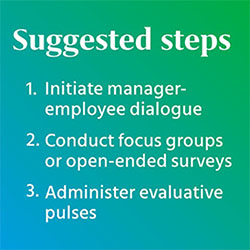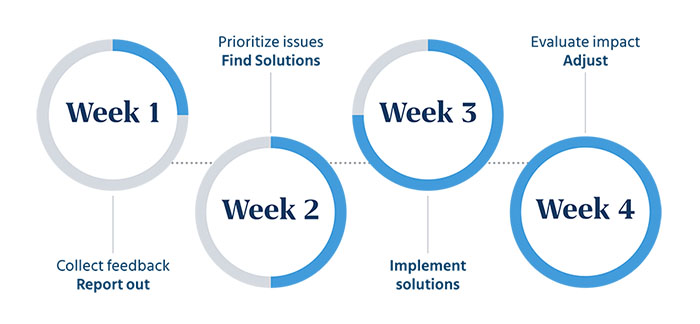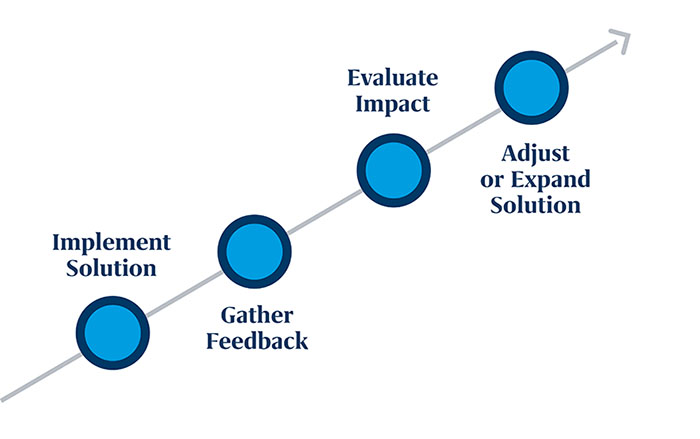The past couple of years have thrown us all for a loop – employers and employees alike. With vaccines rolled-out, mask requirements and social distancing rules lifting, it appears as though we are finally starting to settle into the new normal. However, what does that new normal look like at your organization? And does what you’re proposing or implementing meet the expectations of your employees? There’s only one way to find out – ask your employees what they want.
It’s more important than ever right now to find out: how they are feeling; what they need to excel; and how you can help provide that for them. Even before the global pandemic, employees had ranked empathy as a key characteristic they were seeking in their employers, as revealed in the Mercer Global Talent Trends report back in 2019.
One of your top priorities as an HR professional in today’s labor market is connecting with employees in meaningful ways. That’s really the only way you’ll be able to identify the right actions you can take, offerings you can provide, and programs you can implement that align with your unique employee population.
Your employees are key for keeping your organization afloat, so it’s important they feel confident that leadership is invested in their own wellbeing. Two-way communication is how you instill that confidence in employees.
Let’s take a look at some suggestions for facilitating the conversation.
Craft an efficient and effective listening plan
It’s a good idea to connect with your employees in a variety of ways, typically beginning with the most direct connection: your employees’ managers.
The conversation should span beyond the expected work-related talking points — the manager can demonstrate empathy by asking a variety of questions that touch on all aspects of employees’ lives.
Starting with general questions such as, “How are you doing?” is a good way to establish a natural flow to the conversation.
|
 |
From there, the manager can get into more specific questions that help to facilitate a meaningful two-way exchange. These could include:
- “How is your family?”
- “What can I do to support you at work?”
- “What are you doing to take care of yourself and relieve stress?”
By asking these types of questions, the manager is able to find out how your organization can support the employee, as well as identify any possible challenges or risk factors.
At the same time, engaging this way allows the manager to demonstrate empathy and forge a stronger relationship with the employee.
It might be worth considering whether your organization should advance straight to administering pulse surveys after initiating manager-employee dialogue. Your budget, perceived level of disruption, and the phase your organization is in relative to the crisis/disruption (e.g., responding to the disruption, returning to work, reinventing your organization) will all help you decide which steps to take and in which order.
With many organizations now implementing a permanent remote work option, digital focus group tools can be excellent resources for virtually facilitating dynamic discussions among groups of employees to gain insight on a variety of topics in real-time.
However, a major key to ensuring success is making sure the questions will lead to meaningful insight and actionable outcomes.
With many organizations now implementing a permanent remote work option, digital focus group tools can be excellent resources for virtually facilitating dynamic discussions among groups of employees to gain insight on a variety of topics in real-time.
Another alternative is to deploy evaluative pulse surveys online.
Pulse surveys tend to be short, easy to complete, and focused on one specific topic. They allow employers to quickly and frequently engage employees on a variety of topics, therefore enhancing communication. And they can be deployed easily. Mercer even has several ready-made options that include topics like remote work, senior leader effectiveness, employee wellness, and confidence in the future.
Gaining employee insights on the topics listed above can be of great value to your organization, but the process doesn’t end with your pulse survey. You’ll see the real benefits after you share the results with employees and management has developed its results-driven action plan.
Respond expediently
To reinforce just how important employee feedback is to your organization and to show that you value employees’ time, it’s key to deliver survey results and implement your action plan expediently.
To demonstrate the importance of the feedback provided by employees, consider fast-tracking your response planning and implementation process to gain trust and inspire confidence from your employees.
In a matter of weeks, you need to have collected feedback, identified priorities, implemented solutions, and evaluated the impact (maybe even by deploying follow-up pulse surveys or digital focus groups).

Depending on the situation your organization is facing, you may even choose to deploy a response even more aggressively by turning the actioning process on its head.
If there are clear issues that need to be addressed, perhaps you implement a solution first and then begin gathering feedback. This will allow you to demonstrate your willingness to act and then adjust the solution based on real-time feedback from employees.

However you do it, just engage
During times of crisis, silence from your organization is beyond deafening to your employees; your workforce needs to know that you care about their needs and are managing with confidence.
However you do it, you need to engage with employees — now more than ever.
Mercer is here to help as you navigate through these change and others as they come up. You can select from a variety of ready-to-go tools that will help you efficiently and effectively design a listening plan to meet your needs, address the topics of most concern, and provide your organization with actionable results — all within your budget, so you can deliver a better employee experience.
When you’re ready, we’re here to help. Contact us at surveys@mercer.com or 855-286-5302.